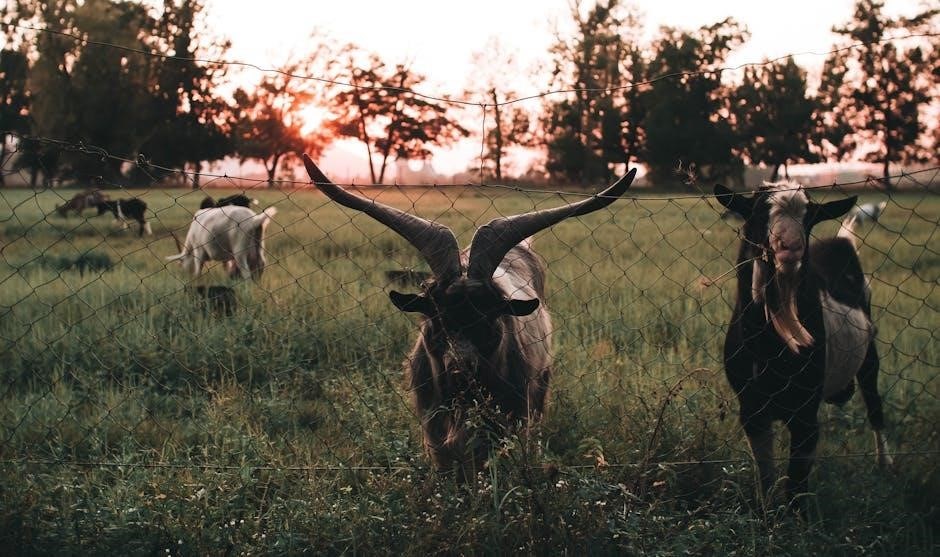The Ram Raksha Stotra is an ancient Sanskrit hymn dedicated to Lord Rama, offering protection and blessings to devotees. Composed by Budhakaushika Rishi, it consists of 38 verses in Anushtup meter, praising Rama’s divine attributes and seeking refuge in Him. This sacred stotra is widely revered for its spiritual significance and protective powers, making it a cherished prayer in Hindu devotion.
Overview of the Stotra

The Ram Raksha Stotra is a sacred Sanskrit hymn comprising 38 verses, composed by Budhakaushika Rishi in the Anushtup meter. This revered prayer is dedicated to Lord Rama, seeking His divine protection and blessings. Each verse extols Rama’s virtues, emphasizing His role as a protector and savior. The stotra is widely recited for its protective qualities, believed to ward off adversities and bring spiritual solace. Its simplicity and profound meaning make it accessible to devotees, while its rhythmic structure enhances its recitation. Available in PDF formats, it remains a popular choice for those seeking refuge in Lord Rama’s grace.
Significance in Sanskrit Literature
The Ram Raksha Stotra holds a revered place in Sanskrit literature as a powerful devotional hymn. Its composition in Anushtup meter and dedication to Lord Rama underscore its cultural and spiritual importance. The stotra is not only a literary masterpiece but also a deeply meditative text, reflecting Hindu philosophy’s essence. Its verses, rich in poetic imagery, highlight Rama’s divine attributes and His role as a protector. Available in PDF formats, it remains a vital part of Sanskrit heritage, offering spiritual solace and inspiration to devotees seeking refuge in Rama’s grace.
Origin and Background
The Ram Raksha Stotra, an ancient Sanskrit hymn, was composed by Budhakaushika Rishi and dedicated to Lord Rama; It is structured in the Anushtup meter and is part of Hindu religious scriptures, emphasizing devotion and protection.
Historical Context
The Ram Raksha Stotra is deeply rooted in ancient Hindu scriptures and Vedic tradition. Composed by Budhakaushika Rishi, it is structured in the Anushtup meter, a traditional Vedic poetic form. This sacred hymn has been passed down through generations, emphasizing its enduring relevance in Hindu devotion. Its origins trace back to the epic Ramayana era, making it a significant part of Lord Rama’s worship. The stotra’s historical significance lies in its ability to provide spiritual protection and solace, making it a cherished prayer in Hindu religious practices for centuries.
Structure and Composition
The Ram Raksha Stotra is meticulously structured with 38 verses, each crafted in the Anushtup meter, a traditional Vedic poetic form; Composed by Budhakaushika Rishi, it adheres to the Seeta-Ramachandra deity and Anushtup Chandah format. The hymn begins with an invocation of Lord Rama, followed by verses that extol His virtues and seek refuge in Him. Each verse is designed to evoke devotion and protection, making the stotra a harmonious blend of spiritual reverence and poetic elegance. Its composition reflects the profound wisdom of ancient Sanskrit literature, ensuring its place as a cherished prayer in Hindu tradition.

Benefits of Reciting Ram Raksha Stotra
Reciting Ram Raksha Stotra offers spiritual growth, mental peace, and emotional stability. It provides divine protection, alleviates fears, and grants blessings, fostering a deeper connection with Lord Rama.
Spiritual Benefits
Reciting the Ram Raksha Stotra bestows profound spiritual benefits, including purification of the soul and alignment with divine grace. It invokes Lord Rama’s protective energy, dispelling negative influences and fostering inner peace. Devotees experience heightened spiritual awareness and a stronger connection to their faith. The stotra is believed to aid in overcoming life’s challenges and achieving spiritual liberation. Regular recitation enhances meditation practices, promoting mental clarity and emotional balance, while also strengthening one’s devotion and commitment to a righteous path.
Mental and Emotional Well-being
Reciting the Ram Raksha Stotra brings profound mental and emotional tranquility, calming the mind and soothing the heart. Its rhythmic verses help alleviate stress, anxiety, and fear, fostering resilience and emotional stability. The stotra’s divine vibrations create a protective shield, enhancing positivity and clarity in thought. Regular recitation strengthens mental focus, promoting self-confidence and emotional balance. It also helps devotees cultivate compassion, patience, and inner harmony, making it an invaluable practice for maintaining mental well-being in today’s fast-paced world. The stotra’s healing energy empowers individuals to face life’s challenges with equanimity and grace.

How to Recite Ram Raksha Stotra
Recite the Ram Raksha Stotra in early morning or evening, seated facing east. Maintain cleanliness, concentrate, and recite with devotion. Chanting its 38 verses brings mental clarity and protection.
Proper Pronunciation
Proper pronunciation of the Ram Raksha Stotra is essential for its spiritual efficacy. Each verse, composed in Sanskrit, must be recited with accurate intonation and rhythm. The stotra follows classical Sanskrit phonetics, emphasizing Swaras (tones) and Vedic accents. Devotees are advised to learn from qualified gurus or reliable audio resources to master the pronunciation. Correctly chanting the stotra ensures its protective and blessings-granting properties are fully realized. Regular practice and mindfulness in recitation enhance the spiritual experience, aligning the chanter with the divine energy of Lord Rama.
Rituals and Practices
The Ram Raksha Stotra is ideally recited during early morning or evening hours in a clean and calm environment. Devotees should bathe, wear clean clothes, and sit facing east or north. Lighting a lamp and offering flowers to Lord Rama is recommended. The stotra should be recited with devotion, maintaining focus and purity of intent. Regular recitation, preferably 11 or 108 times, enhances its protective effects. Many observe fasting or follow specific dietary restrictions while reciting it. Rituals may also include offering prasad and performing aarti after completion. Consulting a guru for proper guidance ensures adherence to traditional practices.
Downloading Ram Raksha Stotra in PDF Format
The Ram Raksha Stotra in Sanskrit can be downloaded as a PDF from authentic sources like official temples, religious websites, or trusted spiritual platforms. Ensure the document is genuine and includes the original Sanskrit text with proper transliteration and translation for better understanding. Many PDF versions also include commentary and guidelines for recitation, making it accessible for devotees worldwide.
Authentic Sources
Authentic sources for downloading the Ram Raksha Stotra in Sanskrit PDF include official temple websites, trusted spiritual platforms, and renowned religious institutions. Ensure the PDF is from a credible publisher to maintain its sanctity and accuracy. Many websites offer free downloads with proper transliteration and translations, making it accessible for global devotees. Verify the source’s reliability to avoid incorrect or incomplete versions of the stotra. Some platforms also provide commentary and guidelines for recitation, enhancing the spiritual experience. Always prioritize downloading from well-known sources to ensure the document’s authenticity and purity.

Language and Script
The Ram Raksha Stotra is composed in Sanskrit, an ancient and sacred language of Hindu scriptures, ensuring its spiritual authenticity. The text is traditionally written in the Devanagari script, which is widely used for Sanskrit texts. PDF versions of the stotra often include the original Sanskrit verses in Devanagari, along with transliterations in the Latin alphabet for easier recitation by non-Sanskrit speakers. Some versions also provide translations in English or other regional languages to facilitate understanding. The script and language preserve the stotra’s divine essence, making it accessible for spiritual practices worldwide while maintaining its traditional integrity.
Related Mantras and Stotras
- The Kalabhairava Ashtakam is another protective mantra, invoking Lord Kalabhairava for safety and blessings.
- Hanuman Kavach complements the Ram Raksha Stotra, offering protection through devotion to Hanuman.
- Nama-Ramayanam and Subrahmanya Sahasra Namavali are sacred Sanskrit texts that enhance spiritual practices.
Similar Protective Hymns
Besides the Ram Raksha Stotra, several other hymns offer similar protective blessings. The Kalabhairava Ashtakam is a powerful mantra dedicated to Lord Kalabhairava, seeking protection from negative energies. The Hanuman Kavach is another potent prayer, invoking Hanuman’s strength for safeguarding against adversities. Additionally, the Subrahmanya Sahasra Namavali and nama-Ramayanam are revered texts that complement the Ram Raksha Stotra, enhancing spiritual protection and devotion. These hymns, like the Ram Raksha Stotra, are deeply rooted in Sanskrit literature and are cherished for their divine protective qualities.
Complementary Sanskrit Texts
Several Sanskrit texts complement the Ram Raksha Stotra, enhancing its spiritual significance. The Kalabhairava Ashtakam is a powerful hymn dedicated to Lord Kalabhairava, offering protection from negativity. The Ganesh Pancharatnam and Shyamala Dandakam are also revered, providing devotion and prosperity. Additionally, the Subrahmanya Sahasra Namavali and nama-Ramayanam are sacred texts that align with the Ram Raksha Stotra’s themes of protection and divine grace. These scriptures, rich in Vedic wisdom, deepen the spiritual practice and blessings associated with the Ram Raksha Stotra.

